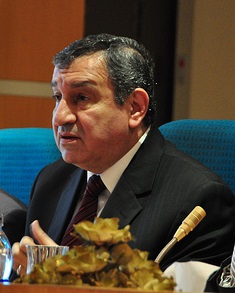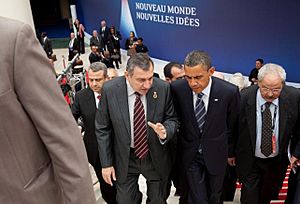Essam Sharaf facts for kids
Quick facts for kids
Essam Sharaf
|
|
|---|---|
|
عصام شرف
|
|

Sharaf in 2011
|
|
| Prime Minister of Egypt | |
| In office 3 March 2011 – 7 December 2011 |
|
| President | Mohamed Hussein Tantawi (Acting) |
| Preceded by | Ahmed Shafik |
| Succeeded by | Kamal Ganzouri |
| Minister of Transportation | |
| In office 1 June 2004 – 15 December 2005 |
|
| Prime Minister | Ahmed Nazif |
| Preceded by | Hamdy El Shayeb |
| Succeeded by | Mohamed Mansour |
| Personal details | |
| Born | 1952 (age 72–73) Giza, Kingdom of Egypt |
| Political party | National Democratic Party (Before 2005) Independent (2005–present) |
| Alma mater | Cairo University Purdue University |
Essam Abdel-Aziz Sharaf is an Egyptian academic and politician. He served as the Prime Minister of Egypt from March 2011 to December 2011. Before that, he was the Minister of Transportation from 2004 to 2005.
Contents
Early Life and Education
Essam Sharaf was born in Giza, Egypt, in 1952. He studied civil engineering at Cairo University, earning his bachelor's degree in 1975.
He then traveled to the United States to continue his studies. At Purdue University, he earned his master's degree in engineering in 1980. He completed his PhD in 1984, also from Purdue.
Career Highlights
After finishing his studies, Sharaf worked as a visiting assistant professor at Purdue University in 1984. The next year, he became an assistant professor at Cairo University. He taught highway and traffic engineering.
In 1990, he worked as an assistant professor of civil engineering in Saudi Arabia. He returned to Cairo University in 1991. By 1996, he was a full professor of highway engineering. During this time, he also advised a transportation and aviation company in Saudi Arabia.
Sharaf became a senior advisor to the Egyptian minister of transport in 1999. In 2003, he advised the municipality of Al Ain in the United Arab Emirates.
Minister of Transportation
Essam Sharaf joined the National Democratic Party. He served as Egypt's Minister of Transportation from July 2004 to December 2005. He resigned from this role due to disagreements with the Prime Minister at the time, Ahmed Nazif.
After his resignation, Sharaf went back to teaching at Cairo University. He often spoke out about problems with Egypt's public transportation. He also advised Dubai's Roads and Transport Authority. He helped start the Egypt Scientific Society with other Egyptian scientists.
Role in the 2011 Revolution
During the 2011 Egyptian revolution, Essam Sharaf was active in the Tahrir square protests. People involved in the democracy movement liked him. They suggested his name to the Military Council as a possible new Prime Minister.
On March 3, 2011, Egypt's military council asked him to form a new government. This happened after the previous Prime Minister, Ahmed Shafik, resigned. The next day, Sharaf spoke to crowds of pro-democracy activists in Tahrir Square. He told them, "I draw my legitimacy from you," meaning his power came from the people. He promised to work towards a democratic Egypt.
Premiership
Essam Sharaf became Prime Minister on March 3, 2011. He was the first Prime Minister of Egypt after the revolution. He replaced Ahmad Shafiq.
In his first few months, he made some popular changes. He removed some unpopular government members. He also got rid of local councils that many people saw as corrupt. He made decisions that were well-received by the public. People saw him as a simple and humble leader.
However, as time went on, his government faced many challenges. These included security issues and problems with public services. His government also passed some laws that caused controversy.
Cabinet Changes
When he first formed his cabinet, Sharaf removed some unpopular ministers. He brought in new people who had been in the opposition during the previous government. However, he also kept some ministers from the old cabinet.
Later, due to public pressure for faster reforms, he changed his cabinet again. He accepted resignations from ministers linked to the time before the revolution. In July 2011, he appointed Hazem Beblawi and Ali El Selmy as deputy prime ministers. Beblawi focused on economic policy, and El Selmy worked on the country's move to democracy.
Challenges in Power
It became clear that the Supreme Council of the Armed Forces (SCAF) held most of the power in Egypt. Sharaf's cabinet still had members from the previous government. He found it hard to remove them without the SCAF's support.
As the period of change continued, people demanded more from the government. Sharaf faced accusations of not doing enough. His leadership was often seen as symbolic, with the SCAF making the real decisions.
Key Policy Reforms
During his time as Prime Minister, Sharaf's government worked on several reforms.
Security
Reforming the country's security system was a big challenge. Sharaf removed many high-ranking officers. However, activists said that the old State Security system, though renamed, still used similar methods.
Media
Initially, Sharaf's government abolished the Ministry of Media. Later, he appointed a new minister, Ossama Heikal, to reform state-controlled media. However, this minister faced criticism for how he handled news coverage of certain events.
Social Initiatives
During his term, the first trade union for farmers in Egypt was created. Sharaf supported this effort to help farmers organize.
Financial Changes
His government approved extra money for the state budget to support goods. He also created a fund to help factories that had stopped working, to prevent job losses. The Ministry of Finance also announced plans for tax reform.
Foreign Relations
Sharaf created a new position for African affairs in the Ministry of Foreign Affairs. This was to improve cooperation with African countries. He visited Ethiopia and Sudan. These visits aimed to improve relations and discuss cooperation on shared resources like the Nile River. For example, Sudan agreed to allow Egypt to plant crops on a large area of land there.
Public Order Challenges
During his term, there were several incidents of public unrest. In May 2011, there was a major incident in a Cairo neighborhood. Later, in October 2011, violence erupted near the National TV Building, known as the Maspiro Incident. These events led to many deaths and injuries. Sharaf was criticized for not being able to control the situation or address the public's concerns effectively.
Resignation
Facing immense pressure, Essam Sharaf submitted his resignation to the SCAF on November 21, 2011. This was just six days before the 2011–12 Egyptian parliamentary election. His resignation was accepted the next day. His cabinet continued to serve temporarily until a new Prime Minister, Kamal Ganzouri, was appointed. Sharaf's last official day as Prime Minister was December 2, 2011.
Political Views
Essam Sharaf is known for his strong opposition to making normal relations with Israel. He believes that the Israeli–Palestinian conflict must be resolved first.
Awards and Honors
- State Encouragemental Prize in Engineering Sciences (1987, 1997)
- First Class Medal of Excellence from the President of Egypt Hosni Mubarak (1995)
- Cairo University Incentive Award for Scientific Excellence in Engineering (1997)
- Egyptian State Prize in Engineering Sciences (1997)
- Excellence Award in Engineering from Purdue University, America (2005)
- Man of the Year Award (Rafiq Hariri Award), Beirut (2006)
- Fellow of the Chartered Institute of Logistics and Transport in the UK (2007)
- Certificate of Merit from the Cairo University (1988, 1998)
- Member of the National Academy of Engineering (2020)
See also
 In Spanish: Essam Sharaf para niños
In Spanish: Essam Sharaf para niños


